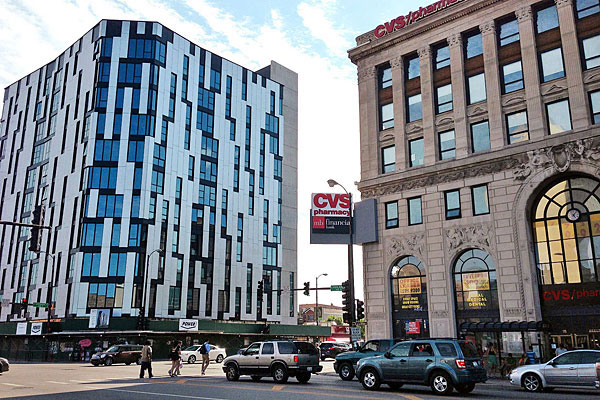Last week I reported that the Belmont-Clark tower, located a block from a Red Line station, may include 90 rental units but only 39 parking spaces. A commenter scoffed, “Good luck renting those apartments when they run out of parking spaces.” However, the 1611 West Division rental tower, which opened last year next to the Division Blue Line stop, shows that new residential buildings near transit with little or, in this case, no tenant parking can be a big success.
I called 1601 West Division L.L.C., the owner of the building, for an update on how things have been going. About 90 percent of the 11-story building’s 99 units are rented, according to staffer Jamie McNally. “Our first move-ins were in October, and we had terrible weather this winter, but it’s only mid-May and we’ve almost leased the entire building,” he said. “Being able to lease a building without [tenant] parking hasn’t been an issue, so we’re pretty happy about how things turned out.”
Conventional wisdom in Chicago says that people who pay premium rent for high-rise living will insist on bringing cars with them. The units at 1611 aren’t cheap, with studios starting at $1,930 a month, and two-bedrooms starting at $2,995. However, the building has no interior parking, and only 16 surface lot spaces: 15 for retail customers and one for Enterprise car-share, which offers a discount to tenants. PNC Bank and Intelligentsia Coffee will be opening at the building later this year, and two other retail tenants are in the works.
The push for car-lite development at the former Pizza Hut site came from local residents, according to McNally. “They wanted a high-density building that would foster a walkable environment,” he said. “We recognized that a lot of young professionals don’t have cars.”
He noted that the building is practically on top of the Blue Line, and near six bus stops and a Divvy station. “You can get pretty much anywhere you need to go without a car. It might be counter-intuitive to some people, but providing more options for people to live near public transportation decreases the need for car parking.” 1611 residents are ineligible for stickers for nearby residential permit parking, but there are commercial lots nearby offering monthly parking.
Instead of indoor car spaces, the building provides a large bike room with a spot for each tenant. A CTA train tracker display in the lobby also facilitates car-free travel.
McNally isn’t sure how many, if any, residents own automobiles, but he guesses that the majority are young professionals who work in the Loop. “If you work downtown, you can get to the Clark and Lake station pretty quickly,” he said. It takes eight minutes, according to Google Maps. “Our tenants are smart. Location matters more to them than having access to a car.”




